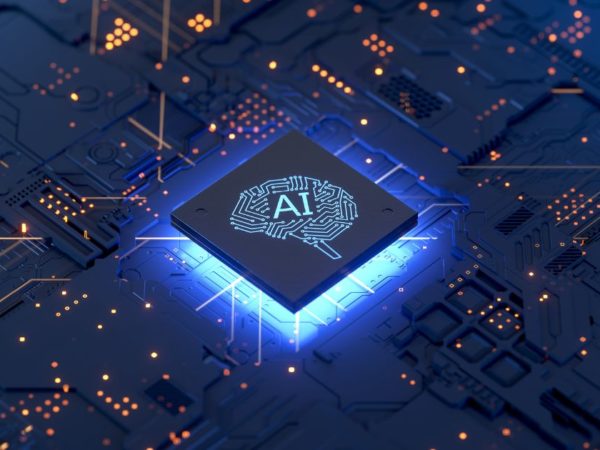No sector or industry is left untouched by the revolutionary Artificial Intelligence (AI) and its capabilities. And it’s especially generative AI creating a buzz amongst businesses, individuals, and market leaders in transforming mundane operations.
Generative AI’s impressive ability to generate diverse and high-quality content—from text and images to videos and music- has significantly impacted multiple fields.
According to Acumen’s research, the global generative AI market is expected to reach $208.8 billion by 2032, growing at a CAGR of 35.1% between 2023 and 2032.
However, the growth of this powerful technology comes with several ethical concerns and issues one can’t ignore, especially those related to data privacy, copyright, deepfakes, and compliance issues.
In this article, we dive deep into these generative AI ethical concerns—what they are and how we can prevent them. But first, let’s look at the Ethics Guidelines the EU formed in 2019 for trustworthy AI.
Ethics Guidelines for Trustworthy AI
In 2019, a high-level AI expert group established Ethics Guidelines for Trustworthy Artificial Intelligence (AI).
This guideline was published to address potential AI dangers at the time, including data and privacy breaches, discriminatory practices, threat of harmful impacts on third parties, rogue AI, and fraudulent activities.
The guideline suggests these three areas a trustworthy AI must rely upon:
- Ethical: It must respect ethical values and principles.
- Lawful: It must respect all applicable laws and regulations.
- Robust: It must ensure robust security from the perspective of technical security and social environment.
Furthermore, the guideline also highlighted seven key requirements an AI system must meet to be deemed trustworthy. The requirements are as listed:
- Human oversight: A trustworthy AI system should empower human oversight and intelligence—allowing humans to make informed decisions as per their fundamental rights.
- Technical safety and robustness: AI systems must be resilient, accurate, reliable, and reproducible, along with ensuring a fall-back plan in case anything goes wrong. This helps prevent and minimize risks of any unintentional harm.
- Data transparency: An AI data system needs to be transparent and come with the ability to explain the decisions it takes to the involved stakeholders. Moreover, humans must be aware and informed of the AI system’s capabilities and limitations.
- Privacy and data governance: Besides ensuring data security, an AI system must ensure adequate data governance measures, considering data quality, integrity, and legitimate data access.
- Accountability: AI systems should implement mechanisms that ensure accountability, responsibility, and audibility that enable the assessment of data, algorithms, or design processes.
- Diversity and non-discrimination: A Trustworthy AI should avoid unfair bias, which can have negative implications. Instead, it should ensure diversity and fairness and should be accessible to everyone, regardless of their disability.
- Societal and environmental well-being: AI systems should be environment-friendly and sustainable, ensuring they also benefit future generations.
While these guidelines made a significant impact in the AI industry, there are still concerns that exist and are even increasing with the rise of generative AI.
Generative AI and The Rise of Ethical Concerns
When talking about ethics in AI, generative AI brings a unique set of challenges, especially with the advent of generative models like OpenAI and ChatGPT.
The particular nature of generative AI brings rise to ethical concerns, majorly in the areas including regulatory compliance, data security and privacy, control, environmental concerns, and copyright and data ownership.
For instance, generative AI can generate human-like text, including images and videos, raising concerns about deep fakes, the generation of fake news, and other malicious content that can cause harm and spread misinformation. Moreover, individuals can also sense a loss of control with AI models’ decisions based on their algorithms.
Geoffrey Hinton, the so-called godfather of AI, said that AI developers must make efforts to understand how AI models may try and take control away from humans. Similarly, many AI experts and researchers are concerned about AI capabilities and ethics.
Chief AI scientist at Facebook and NYU professor Yann LeCun says that the issues and concerns AI could raise for humanity are “preposterously ridiculous.”
Because generative AI grants organizations and individuals unprecedented capabilities to alter and manipulate data—addressing these issues is of the utmost importance.
Let’s look at these concerns in more detail.
Harmful Content Generation and Distribution
Based on the text prompts we provide, AI systems automatically create and generate content that can be accurate and helpful but also harmful.
Generative AI systems can generate harmful content intentionally or unintentionally due to reasons like AI hallucinations. The most concerning situations include deepfake technology, which creates false images, texts, audio, and videos, manipulating a person’s identity and voice to spread hate speech.
Examples of harmful AI content generation and distribution may include:
- An AI-generated email or social media post sent and published on behalf of an organization that may contain offensive and sensible language, harming its employees’ or customer’s sentiments.
- Attackers could also use deepfake to create and distribute AI-generated videos featuring public figures like politicians or actors saying things they didn’t actually say. A video featuring Barrack Obama is one of the most popular examples of deepfake.
<img alt="YouTube video" data-pin-nopin="true" data-src="https://kirelos.com/wp-content/uploads/2023/10/echo/maxresdefault.jpg6538baefc2387.jpg" height="720" nopin="nopin" src="data:image/svg xml,” width=”1280″>
- An example of an audio deepfake is when, recently, a scammer faked a kidnapping by cloning a young girl’s voice to ask for ransom from her mother.
The Spread of such harmful content can have serious consequences and negative implications for an individual’s and organization’s reputation and credibility.
Moreover, AI-generated content can amplify the biases by learning from the training data sets, generating more biased, hateful, and harmful content—making it one of the most concerning ethical dilemmas of generative AI.
Copyright Infringement
Since the generative AI models are trained upon a lot of data, this may sometimes result in the ambiguity of authority and copyright issues.
When AI tools generate images or codes and create videos, the data source from the training data set it refers to could be unknown, as a result of which it can infringe upon the intellectual property rights or the copyrights of other individuals or organizations.
These infringements can result in financial, legal, and reputational damage to an organization—resulting in costly lawsuits and public backlash.
Data Privacy Violations
The underlying training data of the Generative AI Large Language Models (LLMs) may contain sensitive and personal information, also called Personally Identifiable Information (PII).
The U.S. Department of Labor defines PII as the data that directly identifies an individual with details like their name, address, email address, telephone number, social security number, or other code or personal identity number.
Data breaches or unauthorized use of this data can lead to identity theft, data misuse, manipulation, or discrimination—triggering legal consequences.
For instance, an AI model, trained personal medical history data can inadvertently generate a profile that may closely resemble a real patient—leading to security and data privacy concerns and violation of the Health Insurance Portability and Accountability Act (HIPAA) regulation.
Amplification of Existing Bias
Just like an AI model, even a generative AI model is only as good as the training data set that it’s trained on.
So, if the training data set consists of bias, the generative AI amplifies this existing bias by generating biased outputs. These biases are generally prevalent to the existing societal bias and may contain racist, sexist, or ableist approaches in the online communities.
According to the 2022 AI Index Report, 2021 developed a 280 billion parameter model representing a 29% increase in bias and toxicity levels. Thus, while the AI LLM are becoming more capable than ever, they are also becoming more biased based on the existing training data.
Impact on Workforce Roles and Morale
Generative AI models enhance workforce productivity by automating mundane activities and performing daily tasks like writing, coding, analysis, content generation, summarization, customer support, and more.
While on one side, this helps enhance workforce productivity, on the other side, the growth of generative AI also implies the loss of jobs. According to McKinsey’s report, the workforce transformation and AI adoption estimates that half of today’s workforce tasks and activities could be automated between 2030 and 2060, with 2045 being the midpoint year.
Though generative AI adoption means loss of workforce, it doesn’t mean there’s any stopping or the need to curb AI transformation. Instead, employees and workers will need to upskill, and organizations will need to support workers with job transitions without losing their jobs.
Lack of Transparency and Explainability
Transparency is one of the core principles of ethical AI. Yet, the nature of generative AI being black-box, opaque, and highly complex, achieving a high transparency level gets challenging.
The complex nature of generative AI makes it difficult to determine how it arrived at a particular response/output or even understand the contributing factors that led to its decision-making.
This lack of explainability and clarity often raises concerns about data misuse and manipulation, the outputs’ accuracy and reliability, and the testing quality. This is particularly a significant concern for high-stakes applications and software.
Environmental Impact
Generative AI models require a substantial amount of computational power, especially the ones with larger scales. This makes these models consume a lot of energy, which has potential high-risk environmental impacts, including carbon emissions and global warming.
While it’s an overlooked factor of ethical AI, ensuring eco-friendliness is necessary for sustainable and energy-efficient data models.
Fairness and Equity
Generative AI’s potential to produce inappropriate, inaccurate, offensive, and biased responses is another major concern regarding ensuring ethics in AI.
It can arise due to issues like racially insensitive remarks affecting the marginalized communities and creating deepfake videos and images that produce biased claims, distort the truth, and generate content that harms common stereotypes and prejudice.
Accountability
The training data creation and deployment pipeline of generative AI models often complicate the responsibility attribute of AI.
In cases of mishaps, controversies, and unprecedented circumstances, an undefined hierarchy and accountability structure result in legal complications, finger-pointing, and hamper brand credibility.
Without a solid accountability hierarchy, this issue can take a bad turn in no time, intensifying the brand image and damaging the brand’s reputation and credibility.
Autonomy and Control
As generative AI models automate tasks and decision-making processes in various fields, like healthcare, law, and finance—it results in loss of control and individual autonomy. This is because the decisions are majorly driven by AI algorithms instead of human judgment.
For instance, without human intervention, an AI-driven automated loan approval system can determine an individual’s capability to take a loan or creditworthiness based on their credit score and repayment history.
Moreover, generative AI models also sometimes lead to a loss of professional autonomy. For instance, in fields like journalism, art, and creative writing, generative AI models create content that challenges and competes with human-generated work—raising concerns about job displacement and professional autonomy.
How to Mitigate Ethical Concerns With Generative AI? Solutions and Best Practices
While the developments and technological advancements led to generative AI benefits society greatly, addressing ethical concerns and ensuring responsible, regulated, accountable, and secure AI practices are also crucial.
Besides the AI model creators and individuals, it’s also critical for enterprises using generative AI systems to automate their processes to ensure the best AI practices and address the involved ethical concerns.
Here are the best practices organizations and enterprises must adopt to ensure ethical generative AI:
✅ Invest in robust data security: Using advanced data security solutions, like encryption and anonymization, helps secure sensitive data, personal data, and confidential company information—addressing the ethical concern of data privacy violation related to generative AI.
✅ Incorporate diverse perspectives: Organizations must incorporate diverse perspectives within the AI training data set to reduce bias and ensure equity and fair decision-making. This includes involving individuals from diverse backgrounds and experiences and avoiding designing AI systems that harm or disadvantage certain groups of individuals.
✅ Staying informed about the AI landscape: The AI landscape keeps evolving consistently with new tools and technologies—giving rise to new ethical concerns. Enterprises must invest resources and time to understand the new AI regulations and stay informed of the new changes to ensure the best AI practices.
✅ Implementing digital signatures: Another best practice experts suggest to overcome generative AI concerns is using digital signatures, watermarks, and blockchain technology. This helps trace the generated content’s origin and identify potential unauthorized use or tampering of the content.
<img alt="YouTube video" data-pin-nopin="true" data-src="https://kirelos.com/wp-content/uploads/2023/10/echo/maxresdefault.jpg6538baf012eb2.jpg" height="720" nopin="nopin" src="data:image/svg xml,” width=”1280″>
✅ Develop clear ethical guidelines and usage policies: Establishing clear ethical guidelines and usage policies for the use and development of AI is crucial to cover topics like accountability, privacy, and transparency. Moreover, using established frameworks like the AI Risk Management Framework or the EU’s Ethics Guideline for Trustworthy AI helps avoid data misuse.
✅ Align with global standards: Organizations must make themselves familiar with global standards and guidelines like the UNESCO AI Ethics guidelines that emphasize four core values, including human rights and dignity, diversity and inclusiveness, peaceful and just societies, and environmental flourishing.
✅ Foster openness and transparency: Organizations must foster AI use and development transparency to build trust with their users and customers. It’s essential for enterprises to clearly define the workings of AI systems, how they make decisions, and how they collect and use data.
✅ Consistently evaluate and monitor AI systems: Lastly, consistently evaluating and monitoring AI systems is crucial to keep them aligned and ethical per the set AI standards and guidelines. Hence, organizations must perform regular AI assessments and audits to avoid risks of ethical concerns.
Conclusion
While generative AI offers significant benefits and revolutionizes multiple sectors, understanding and addressing the surrounding ethical concerns is crucial to fostering responsible and secure use of AI.
The ethical concerns around generative AI, like copyright infringement, data privacy violations, distribution of harmful content, and lack of transparency, call for strict regulations and ethical guidelines to ensure the right balance and robust and accountable use of AI.
Organizations can leverage AI’s power to its maximum potential with minimal to no ethical risks and concerns by implementing and developing ethical rules and guidelines and following the best AI practices.
Next, check out AI statistics/trends that will blow your mind.



